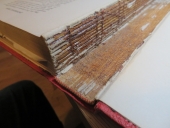posted 7 years ago
That looks like a pretty good repair job.
I am a bookbinder by trade, and have had to do this not only on books of my own that I've trashed, but also on everything from worn-out kids' books to family heirloom bibles.
It is by far easiest to reattach a cover, especially if the outermost pages, usually a pair of folded double-size pages on the outside of the book block (called endpapers, for obvious reasons) are intact. On sewn books, these can be either sewn into the spine or tabbed on with PVA. If there are blank pages attached to the book block, reinforcing these, attaching new endpapers, and gluing the original cover onto them is the best way to repair that sort of damage.
Also common is when the spine of a book disintegrates. This is most easily fixed with book binders' cloth, or bindery tape, which is simply book binders' cloth with a bonded adhesive. It is possible to stencil atop most bindery tape, even to the point of being able to foil stamp or hand-foil, should that be your thing.
If the cover itself is falling apart more than just at the spine, it is often necessary to photocopy what remains and create a new case for the book entirely. You can, incidentally, create a case and glue any book block into it (a process known as casing-in), as long as you add endpapers to secure the new case to the outside of the book block without attaching it to the spine, which, as mentioned in an earlier post, needs to move freely to allow the book to open properly, without damage.
A case is simply two pieces of harder material cut to just larger than the book block (usually 1/8th of an inch around, so a quarter inch extra up, down, and on the face, but the measurement is finicky), then wrapped with either book binders' cloth or a printed paper wrap. The boards can be made of a few different materials, but padding or chip board is most often used. If a hard strip is used on the spine, then it is usually cut to the width of the book block plus the thickness of the boards, or in other words, the thickness of the closed book. This is centered on the case material, and the front and back boards are placed accordingly, with spacing of approximately one-and-a-half times the thickness of the board material left between the spine and the front and back boards to allow for hinge movement.
The case wrap is usually cut so that there is at least 3/4s of an inch of wrap on each edge. PVA can be used, but a flour-based paste can be used instead, though the drying time would need to be increased. The adhesive is applied to the inside of the casewrap, the boards are placed, and the edges wrapped around the properly positioned board material.
The corners of the casewrap are usually cut so that there is less material build-up on the corners of the wrapped cases.
The hardest thing, by far, is to reglue or resew bookblocks that have come apart. In the case of paperback-style glued books and bookblocks, there's very little recourse but to gather all the pages, jog the paper down to the spine, and clamp it. I would use a fine rasp or file, something that will rough up the edges of the paper without doing damage; on a digitally printed one-off, I would use a sanding block. This gives the glue more surface area with which to bind.
Sewn books, incidentally, can be lots of work, or they can be damaged to the point of being unbindable without reprinting large sections or grinding off the folded and sewn remnants and making it into a glued book block. These usually have pages gathered in sections, eight or sixteen per is common, double-sized, folded, and gathered into sets, which are then stitched together into book blocks. You can imagine how involved a process it is to replace a single page that falls out of such a book (as you would need to disassemble the spine and replace not only the page that fell out, but the one that it was attached to, and probably the pages next to it in the folded set).
As to glue, basically any glue that remains relatively elastic when dry will work for the gluing of spines, but those suited specifically for paper will obviously do best.
I hope some of this will prove useful to the home-scale book binder and repairer. Good luck, and please post more shots of book repair!
-CK
A human being should be able to change a diaper, plan an invasion, butcher a hog, conn a ship, design a building, write a sonnet, balance accounts, build a wall, set a bone, comfort the dying, take orders, give orders, cooperate, act alone, solve equations, analyze a new problem, pitch manure, program a computer, cook a tasty meal, fight efficiently, die gallantly. Specialization is for insects.
-Robert A. Heinlein












